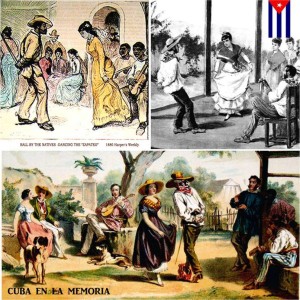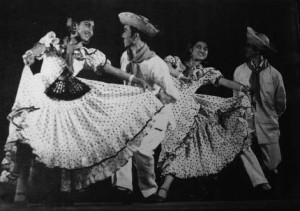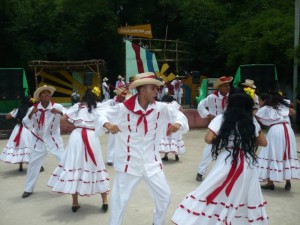![]() ORIGINS OF A CRIOLLO DANCE: “THE CUBAN ZAPATEO”. OPINIONS.
ORIGINS OF A CRIOLLO DANCE: “THE CUBAN ZAPATEO”. OPINIONS.
The “Cuban zapateo”, according to many authors, is a Cuban dance of Spanish origin and states that emerged in rural areas, so it is logical “peasant” music is considered. In fact, in Cuba, I remember only played in some programs of this genre, such as the classic “Palmas y Cañas”.
It is believed that since 1550, the first settlers began to develop on the island a fondness for dances that were the main attraction dragged feet or tap dance. Possible Andalusian origin, ensures came from some dances of Celtic influence in Europe. Other historians and researchers attribute to it a Canarian root.
Alejo Carpentier in his book “Music in Cuba” believes that the first signs of the appearance of foot stomping on the island, dating from the early eighteenth century, although it was not until the second half of the nineteenth century when it reaches its peak. He also states that no representative becomes a dance of Cuban culture, until the first two decades of the twentieth century.
. In an article in the magazine “La Charanga” Volume 2, No. 21-25 published in Havana in October 1858, meeting:
“… To hear are excited and happy so that forgetting one his misadventures and the other its high social position, put, without be given a damn about what people will say, to dance zapateo then everyone snatches …”
In considering its emergence in rural areas, the Cuban musicologist Rolando Antonio Perez states that during the sixteenth, seventeenth and eighteenth centuries was manifested in Cuba a trend towards the settlement of the inland areas and to the ruralization of Hispanic traits … “that before they had at headquarters cities. ”
That is, that the process of evolution of footwork starts in urban settings, and then expanding to rural areas as a natural process of settlement of the island. It is true that was not limited to the urban landscape, as among the peasants there was also a dance, with peculiarities that unlike the style common to more than one region of America: the Cuban zapateo.
Canary source of tap dancing is a deep-rooted belief in the Cuban people. It seems logical given the significant settlement of immigrants canaries in the fields of Cuba, where more this genre was developed. But this argument is dismissed because in the history of the Canary Islands there are no references to any kind based on the musical poetic improvisation that could have served as a starting point for further development of this dance.
Perhaps the strongest argument against the hypothesis of Canary origin point is precisely that in the Canary Islands called this genre “punto cubano” in clear recognition of its origin in our country.
In the book “Music and history Zapateado” the Spanish Guillermo Castro Buendia, many bibliographical notes of the Hispanic press not hesitate to confirm the Cuban nationality of our zapateo they appear:
May 1842, “The Last Goodbye”.
… “With this title we have seen advertised in the newspaper yesterday the last function of the sublime daughter of the Rhine, that next Sunday will be verified. It will dance the sorceress
Fairy, “Zapateado Cuban Buscapié” who has learned this week … ”
August 1844, “Mouths of the island”
… “New song with very funny lyrics that sing with all the gaditana sandunga the young Don Victor Valencia … Ms. Maria Arroyo will be presented, with the provision that is
natural, will dance the true “Cuban zapateado” which will accompany the harp, tiple, guitar and guiro.
However, there is no doubt that the taconeo, gestures and, in general, the assumed pace reminiscent of intentionality “choreographic Andalusian” said the Cuban composer wrote Sanchez de Fuente.
There are many references, and consolidated the Spanish domination of its colonies, they begin to return to Spain many Spaniards, accompanied by their black slaves, who brought crossbred and customs created in the Caribbean, especially in music and dance. Of Cuba they will arrive various instruments, and some were adapted to their culture, such as the guiro, calabash, and the jawbone of an ass.
The simple Cuban musical instrument called “guiro” is simply the fruit of the tree we call güira. The fruit is shaped like elongated pumpkin, once dried, they will make several parallel stripes consecutive by one side and that, when scratched with a whisk produces the familiar, rhythmic sound that accompanies the Cuban music of all time.
The tap dance is a dance of loose couple, and its most notable feature is the game of the feet, alternating toe and heel, basic step that gives name to the dance, while marking the rhythm of the music beat six eight, with singing and tap-off participants.
The woman, upright, holding her apron or skirt with both hands, while the man leans slightly forward with crossed behind the hips, pretending to pursue the body of the companion with his head, as does the rooster arms with hen during courtship mating. There are even references to the more experienced dancers knives were placed on shoes, imitating spurs cock and doing dangerous corridors.
The man turns around the woman, who tries not to turn their backs, so it rotates on its own axis, accentuating the masculine and feminine coquetry flirtation. The choreographic drawings are free and spontaneous, and other steps known as “escobillado” and “flourish”, which can be performed quickly or slowly are presented. She provokes him and he ends dancing placing his hat on his head or his scarf on shoulders.
CUBAN Zapateo
. In the magazine “Sport”, Year 3, No. 14-16, January 1888, said:
“… In the superior races primitive dances was the subject of love. delicate love, still usually rises gently from the dancers move with them and placid embriagarlos with heat, while serenaded notes delicious music. The Cuban Zapateo, the Neapolitan Tarantella, the Tuscan Frascone, German Walz, the Polish Mazurka, the Romeka and Greek Arnauta, they are but dances of love? … ”
Regarded as “dance guajiros” unfortunately fell into disrepute and was sidelined. And although I do not consider to be updated or become popular as a ballroom dance, we should not forget it, because it is Cuban and part of our culture and our roots. And, no doubt, he is forgotten, like so many other things …
Agencies/Memorias de Cuba/Derubín Jácome/Internet Photos/Extractos.
The Cuban History, Hollywood.
Arnoldo Varona, Editor.
CUBA PHOTOS.
![]() ORÍGENES DE UN RITMO CRIOLLO: “EL ZAPATEO CUBANO”. OPINIONES.
ORÍGENES DE UN RITMO CRIOLLO: “EL ZAPATEO CUBANO”. OPINIONES.
El “zapateo cubano”, según muchos autores, es un baile cubano de origen español y se afirma que surgió en las zonas rurales, por lo que es lógico se considere música “campesina”. De hecho, en Cuba, recuerdo que solo se interpretaba en algunos programas de este género, como el clásico “Palmas y Cañas”.
Se cree que desde 1550, los primeros colonizadores empezaron a desarrollar en la Isla una afición por bailes que tenían como principal atractivo el arrastrado de los pies o zapateado. De posible procedencia andaluza, se asegura provenía de algunas danzas de influencia celta en Europa. Otros historiadores e investigadores le atribuyen una raíz canaria.
Alejo Carpentier en su libro “La música en Cuba”, considera que los primeros indicios de la aparición del zapateo en la Isla, datan de principios del siglo XVIII, aunque no fuera hasta la segunda mitad del siglo XIX cuando alcanza su mayor auge. También afirma que no se convierte en un baile representativo de la cultura cubana, hasta las primeras dos décadas del siglo XX.
En un artículo de la revista “La Charanga” Tomo 2, Núm. 21-25 publicada en La Habana en Octubre de 1858, encuentro:
“…al oírlo se entusiasman y alegran de tal manera que olvidando una sus desventuras y el otro su elevada posición social, se ponen, sin dárseles un bledo por el qué dirán, a bailar el zapateo, entonces, todo el mundo se arrebata…”
En cuanto a considerar su surgimiento en las zonas campesinas, el musicólogo cubano Rolando Antonio Pérez expone que durante los siglos XVI, XVII y XVIII se manifestó en Cuba una tendencia hacia el poblamiento de las zonas interiores y hacia la ruralización de rasgos hispánicos… “que antes tuvieron por sede las ciudades”.
Es decir, que el proceso de evolución del zapateo comienza en los medios urbanos, y es después que se expande hacia las zonas rurales, como proceso natural de poblamiento de la Isla. Es cierto que no estuvo limitado al paisaje urbano, pues entre los campesinos también existió una danza, con particularidades que la diferencia del estilo común a más de una región de América: el zapateo cubano.
La procedencia canaria del zapateo es una creencia arraigada en el pueblo cubano. Parece lógico si consideramos el significativo asentamiento de inmigrantes canarios en los campos de Cuba, donde más se desarrolló este género. Pero este argumento queda descartado porque en la historia de las Islas Canarias no existen referencias a ningún género basado en la improvisación poético musical que pudiera haber servido como punto de partida para el desarrollo posterior de este baile.
Quizás el más sólido argumento en contra de la hipótesis del origen canario del punto sea precisamente que en las Islas Canarias se le llama a este género “punto cubano”, en evidente reconocimiento de su procedencia de nuestro país.
En el libro “Música e historia del Zapateado” del español Guillermo Castro Buendía, aparecen muchas notas bibliográficas de la prensa hispana que no dudan en confirmar la nacionalidad cubana de nuestro zapateo:
Mayo de 1842, “El último adiós”.
…”Con este título hemos visto anunciado en el diario de ayer la última función de la sublime hija del Rhin, que se verificará el domingo próximo. En ella bailará la hechicera
Hada, el “Zapateado Buscapié cubano” que ha aprendido en esta semana …”
Agosto de 1844, “Las bocas de la Isla”
…”Canción nueva con letra muy chistosa que cantará con toda la sandunga gaditana el joven Don Víctor Valencia… Se presentará Dª María Arroyo, con la disposición que le es
natural, bailará el verdadero “zapateado cubano”, que le acompañarán con arpa, tiple, guitarra y güiro.
Sin embargo, no hay dudas de que el taconeo, la gestualidad y, en general, el ritmo asumido recuerda a la intencionalidad “coreográfica andaluza”, según escribió el compositor cubano Sánchez de Fuente.
Existen muchas referencias que, ya consolidada la dominación española sobre sus colonias, empiezan a regresar a España muchos españoles, acompañados de sus esclavos negros, que traían costumbres ya mestizas creadas en el Caribe, sobre todo en la música y la danza. De Cuba les llegarán instrumentos diversos, y algunos se adaptaron a su cultura, como el güiro, calabazo, y la quijada de burro.
El simple instrumento musical cubano llamado “güiro”, no es más que la fruta del árbol que llamamos güira. El fruto tiene forma de calabaza alargada, el que una vez secado, se le hacen varias rayas paralelas consecutivas por uno de los lados y que al frotarse con unas varillas produce el consabido y rítmico sonido que acompaña a la música cubana de todos los tiempos.
El zapateo es un baile de pareja suelta, y su característica más notable es el juego de los pies, alternando la punta y el tacón, paso básico que le da nombre al baile, sin dejar de marcar el ritmo de la música en compás de seis por ocho, con el canto y el palmeo de los participantes.
La mujer, erguida, sostiene su delantal o falda con ambas manos, mientras el hombre se inclina ligeramente hacia delante con los brazos cruzados por detrás a la altura de las caderas, simulando perseguir el cuerpo de la compañera con su cabeza, como hace el gallo con la gallina durante el cortejo de apareamiento. Incluso hay referencias de que los bailadores más experimentados se colocaban cuchillos en los zapatos, imitando espuelas de gallo y haciendo peligrosos pasillos.
El hombre gira alrededor de la mujer, quien trata de no darle las espaldas, por lo que ella va girando sobre su propio eje, acentuando el galanteo masculino y la coquetería femenina. Los dibujos coreográficos son libres y espontáneos, y se presentan otros pasos conocidos como “escobillado” y “floreo”, los cuales puede realizarse con rapidez o lentamente. Ella lo provoca y él culmina el baile colocándole su sombrero en la cabeza o su pañuelo sobre los hombros.
EL ZAPATEO CUBANO
En la revista “Sport”, Año 3, Num. 14-16, Enero de 1888, se comenta:
“…En las razas superiores el primitivo objeto de los bailes fué el amor. Amor delicado, que aún suele elevarse dulcemente de los bailarines, moverse con ellos y embriagarlos con plácido calor, en tanto que los arrullan las notas de una música deliciosa. ¡El Zapateo cubano, la Tarantella napolitana, el Frascone toscano, el Walz alemán, la Mazurka polaca, la Rómeka y la Arnauta griega, que son sino bailes de amor?…”
Considerado como “baile de guajiros” cayó en descrédito y lamentablemente fue marginado. Y aunque no considero que deba actualizarse o hacerse popular como un baile de salón, tampoco debemos olvidarlo, porque es cubano y forma parte de nuestra cultura y de nuestras raíces. Y, sin dudas, está olvidado, como tantas otras cosas…
Agencies/Memorias de Cuba/Derubín Jácome/Internet Photos/Extractos.
The Cuban History, Hollywood.
Arnoldo Varona, Editor.








